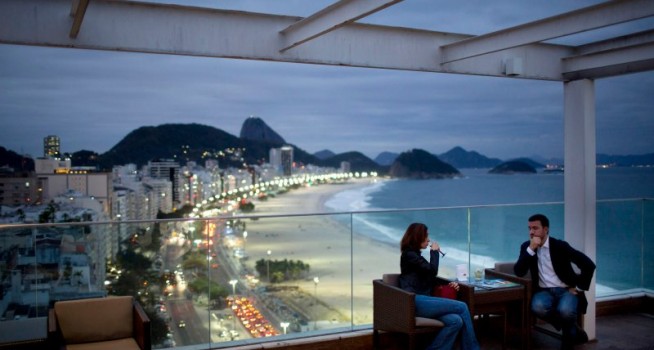Coming up with the ten biggest changes in travel of 2013 got me contemplating what 2014 might have in store. Here are a few predictions for the new year:
1. More people will travel to eat.
They’re already flying to Copenhagen for the weekend just to eat at Noma, or to Lima specifically for Gaston Acurio’s new Peruvian cuisine, or to San Sebastian, Spain, for its 16 Michelin stars. In 2014 such foodie meccas will be joined by countries you might never have expected to be extolled for their eats: Scotland (whose restaurants now total 17 Michelin stars), Australia (here’s why), and even Georgia (the one in the Caucasus, renowned for outstanding organic food and 8,000 years of winemaking). Our obsession with authentic regional cuisine and the origins of its ingredients will grow, with more travelers wanting to take local cooking classes, go with chefs to food markets, meet farmers and cheese makers and winemakers, even stomp grapes. (For more on this, here’s a talk I gave on the topic earlier this year.)
2. Travelers will increasingly choose homes over hotels.
It’s nothing new to want the space, privacy, local flavor, and savings that come with renting an apartment or vacation home. (Indeed, I’ve been selecting the best villa rental agents for eight years now.) In 2013, though, the biggest vacation-rental-market disruptors grew even more disruptive: Airbnb started training its home owners in the art of hospitality, and HomeAway introduced a new site focused on luxury villas. Next year hotels will need to find new ways to keep customers loyal or new services to sell. Which explains Predictions 8, 9, and 10….
3. Hotels will offer to help you in your personal life.
They’ll try to be a go-to source not just when you’re traveling but when you’re at home too. Last summer Four Seasons offered its Sommelier on Call to help people figure out what wine to serve when entertaining in their home. Mohonk Mountain House, the historic resort in upstate New York that offers meditation programs, recently started a Mindfulness Moment Hotline that anyone can call in a moment of stress if they want to be calmed. More hotels will likely find similar ways to try to stay top of mind among potential customers.
4. Hotels will become more photogenic.
With luxury travel being redefined as “Instagram-able experiences,” hotels will take a cue from “the world’s first Instagram hotel”—the 1888 in Sydney, Australia—and add unique touches and visual details designed to excite the Instagram crowd into snapping and sharing pics, generating buzz within their social network. More and more properties will also use Instagram to connect with current and future guests, answering questions, troubleshooting, and making recommendations. Engage with a hotel on Instagram and it could get you special treatment.
5. Hotels will rent you office space (complete with spas and bars).
More and more hotels are renting out work spaces, converting meeting rooms into pop-up offices for use by a growing crop of mobile workers, including Gen Xers and Millennials who are more comfortable not in traditional office cubicles but in Starbucks-like spaces where they can both work and socialize. Marriott recently expanded its Workspace on Demand program and Westin introduced Tangent, while many hotels are catering to 24-hour business travelers in need of “microstays” by renting out rooms on a day-use or even hourly basis.
6. More hotels—and even cruise lines—will join the 21st century and offer free Wi-Fi.
Wi-Fi is a necessity just like running water, and any hotel that charges for it will rethink when they find travelers taking their business elsewhere. The latest luxury hotel group to cave was Rocco Forte Hotels, which announced last month that in-room Wi-Fi is now free. (Here’s HotelChatter’s chart showing which hotel brands now offer free Wi-Fi.) As for cruise lines, Regent Seven Seas plans to offer free Wi-Fi to some passengers starting late next year, Viking Ocean Cruises has promised free Wi-Fi for all on its Viking Star launching in 2015, and Silversea already offers a free onboard service that provides news broadcasts and newspapers to passengers’ Wi-Fi-enabled devices. Several other cruise lines are planning technology upgrades that should make onboard Internet access faster and, if not free, at least cheaper.
7. You’ll have greater access to comfort when you fly.
With more pay-as-you-go club lounges opening in U.S. airports, with tools like Routehappy to point you to the nicest planes and seats for your route, and with several airlines, including American, letting ordinary passengers (not just frequent fliers) bid for upgrades to first class, comfort in the skies and in airports will be within reach of a greater swath of people.
8. You’ll design itineraries visually, using images as building blocks.
I’m seeing it all over: Peek, a site for finding interesting activities and half-day tours, invites you to create your Perfect Day at the destination you’re headed to by dragging photos of the things you want to do onto a timeline. Mygola has you click on photos of sites, activities, restaurants, and shops, then arranges them on a multi-day timeline, claiming to factor in opening times and best routes. Four Seasons offers Pin.Pack.Go, where you can create a Pinterest board to plan an upcoming trip and a destination expert at the property you’re headed to collaborates with you, pinning insider recommendations to your board.
Read more on http://www.thedailybeast.com/articles/2013/12/28/14-travel-predictions-for-2014.html
http://www.thedailybeast.com/articles/2013/12/28/14-travel-predictions-for-2014.html













